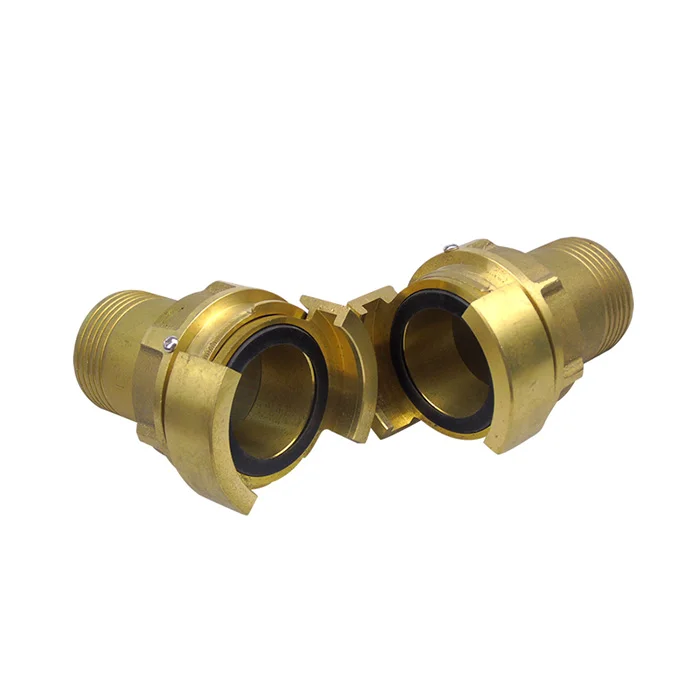Firefighters are the unsung heroes who put their lives on the line to protect us and our properties from the devastating effects of fires. To effectively combat fires, they rely on specialized equipment, including fire hose couplings. One such coupling is the NorwegianNor type, known for its durability and reliability in extreme conditions. In this blog post, Jingqi will delve into the intricate manufacturing process behind the NorwegianNor type fire hose coupling. By understanding the steps involved, we can appreciate the craftsmanship and engineering that goes into creating this essential firefighting tool.
Manufacturing process of NorwegianNor type fire hose coupling for sale
1. Design and Material Selection
The manufacturing process of NorwegianNor type fire hose couplings begins with meticulous design and material selection. Engineers and designers work closely to create a coupling that meets the highest industry standards. The design must consider factors such as pressure resistance, durability, and compatibility with existing firefighting equipment.
The material selection is crucial to ensure the coupling's performance and longevity. Typically, NorwegianNor type couplings are made from high-quality materials like aluminum, brass, or stainless steel. These materials offer excellent corrosion resistance, strength, and lightweight properties, making them ideal for firefighting applications.
2. Casting or Machining
Once the design and material selection are finalized, the manufacturing process moves to either casting or machining, depending on the chosen material. Casting is commonly used for aluminum and brass couplings, while machining is preferred for stainless steel couplings.
In casting, the chosen material is melted and poured into a mold that has the shape of the coupling. The molten material fills the mold, taking its form, and is left to cool and solidify. Afterward, the coupling undergoes various finishing processes, such as sandblasting, polishing, and deburring, to achieve the desired surface finish.
For machining, a solid block of the chosen material is carefully shaped using precision tools like lathes, milling machines, and CNC (Computer Numerical Control) machines. This process requires skilled operators who meticulously follow the design specifications to create the intricate features of the coupling.
3. Thread Cutting and Assembly
The next step in the manufacturing process involves thread cutting and assembly. Threads are crucial for securely connecting the fire hose to the coupling. The coupling undergoes a thread cutting process, where precise threads are cut into the coupling's interior and exterior surfaces.
After thread cutting, the coupling is thoroughly cleaned to remove any debris or contaminants. Then, the coupling is assembled with other components, such as gaskets and locking mechanisms, to ensure a tight and leak-free connection.

4. Quality Control and Testing
Quality control is an integral part of the manufacturing process for NorwegianNor type fire hose couplings. Each coupling undergoes rigorous testing to ensure it meets the required standards and specifications. These tests include pressure testing, leak testing, and dimensional inspections.
Pressure testing involves subjecting the coupling to high-pressure conditions to verify its ability to withstand the expected firefighting pressures. Leak testing ensures that the coupling maintains a secure connection without any leakage. Dimensional inspections verify that the coupling's dimensions align with the design specifications.
5. Surface Treatment and Coating
To enhance the coupling's durability and resistance to corrosion, surface treatment and coating are applied. This step involves processes like anodizing, electroplating, or powder coating, depending on the chosen material.
Anodizing is commonly used for aluminum couplings, creating a protective oxide layer on the surface. Electroplating involves depositing a layer of metal, such as chrome or nickel, onto the coupling's surface to enhance its appearance and corrosion resistance. Powder coating involves applying a dry powder to the coupling's surface, which is then cured to form a durable and attractive coating.
Conclusion
The manufacturing process of NorwegianNor type fire hose couplings combines precision engineering, skilled craftsmanship, and stringent quality control measures. From design and material selection to casting or machining, thread cutting and assembly, quality control and testing, and surface treatment and coating, each step plays a vital role in creating a coupling that can withstand the demanding conditions faced by firefighters. By understanding the intricacies of this manufacturing process, we can appreciate the dedication and expertise that goes into producing these essential firefighting tools.
https://www.harry-fire.com/Manufacturing-process-of-NorwegianNor-type-fire-hose-coupling.html
Jingqi
jingqi888@aliyun.com

More Stories
Selecting the Right Mini PC Industrial i5 for Embedded Control, IoT, and Smart Manufacturing Applications
Essential Tips for Maintaining Aluminum Profiles After Professional Mechanical Polishing
Maximizing Efficiency and Precision with Horizontal Machining Centers